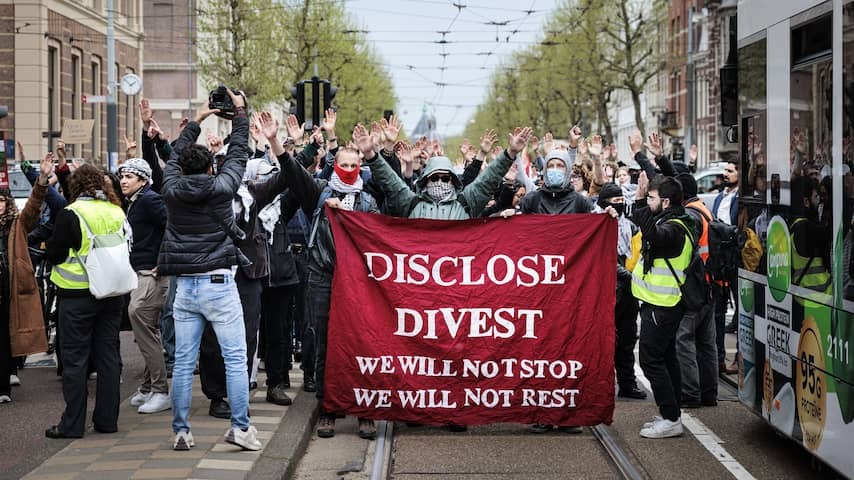
The aggression of pro-Palestinian protesters at a Utrecht council meeting last week led to a report to the police on Monday. And to questions from NU.nl readers. Don’t such actions undermine support and thus prevent change? But outrage often leads to change.
The pro-Palestinian demonstration on Friday was not the only protest that caused outrage. For example, dozens of people were arrested at a riotous demonstration in Rotterdam early last month. And at an earlier action in Amsterdam, police arrested 281 protesters.
It’s not just about pro-Palestinian actions. Highway blockades by climate action group Extinction Rebellion or farmers’ protests at town halls also regularly cause a stir. And that commotion provokes resistance from NU.nl readers, among others. Not really the way to change public opinion, you might think.
But the very purpose of such a demonstration is to create some friction, Rowie Stolk explains to NU.nl. As a lecturer in constitutional and administrative law at Leiden University, she researches organizations that litigate on social issues such as climate, refugee reception, or nitrogen.
According to Stolk, change and outrage are not mutually exclusive. “Farmers’ protests around nitrogen caused social outrage on the one hand, but on the other hand, it received a lot of attention in politics.” A lot of attention ensures that the social discussion gets underway. That can lead to the public looking at it differently and it ending up on the political agenda. Until there is even a change in policy: the ultimate goal of a demonstration.
Outrage is therefore desirable in such an action: this is how the theme ultimately becomes the subject of the debate. “You’re allowed to be a bit difficult,” says Stolk. “You want to make a sound that is not popular in politics and society.” She emphasizes that violence is not the solution. “Protests must remain peaceful. Otherwise, it is against the law.”
Demonstrations are supposed to be abrasive
“Demonstrations are supposed to be abrasive,” says human rights lawyer Jelle Klaas. “Otherwise, they don’t have much effect.” That is why the right to demonstrate is so important. You must be able to express your opinion, even if that opinion is not desired. This is how citizens keep each other sharp in a democracy.
An example of this can be seen in the photo above this article. Pro-Palestinian activists have gathered there at the National Holocaust Museum. Many people find that choice of location unpleasant and inappropriate. But that is precisely what many protesters are about: drawing attention where it hurts.
Action groups seem to be looking for a sweet spot: when does the search for attention go ‘too far’? Extinction Rebellion, for example, wants to stay away from violence, but it does occupy the highway. Also illegal and drastic, but peaceful. Stolk: “You want to go just far enough that your message gets across.”
Change doesn’t happen all at once
It is difficult to say whether only (aggressive) demonstrating is ‘successful’ and thus leads to change. “Demonstrating is not the only thing people do. It is often a combination of lobbying, demonstrating, litigating, and starting petitions,” says Stolk. But what is certain is that the message of the protesters must be heard.
And change takes time, says Stolk. “Social change never happens in a straight line. Sometimes you take one step forward and two steps back.” Demonstrations are about themes that are contentious, precisely because they go against prevailing views. Most people are not comfortable with it. And that is why it often takes years for something to change.
Think of Black Pete: the first years in which its appearance was questioned caused a lot of resistance. In the meantime, the Petes are painted in fewer and fewer places, and then Prime Minister Mark Rutte also said that his opinion on it had changed.
Suffrage for women not without a struggle
Klaas also mentions the example of women’s suffrage. “Large groups of people were against women’s suffrage before it was introduced. But then women’s rights movements started demonstrating. Also in a disruptive way, for example by disrupting church services.” Partly because women demanded attention in that annoying way, they still got the right to vote, says the human rights lawyer. “And now almost everyone thinks it was a good fight.”
Another example: the Dutch protests for gay rights in the 1970s. These initially provoked a lot of resistance, for example during a so-called kissing action in which people of the same sex started kissing each other in a square. “Some opponents naturally thought that was terrible.”
According to Klaas, this happens automatically with major social subjects that involve a lot of emotion. Shifting public opinion on such a sensitive issue takes time and has many sides. “Gaza demonstrations are also not about the construction of some garden fence, but about genocide. The government and Dutch municipalities can also play a role in this.”
It is not always certain that such actions will ultimately lead to change. But the longer a topic is on the political agenda, the greater that chance becomes. Stolk: “If there are conversations about it for a longer period of time, people start thinking and the realization can gradually dawn: maybe we have been wrong all this time.” Support can then gradually increase, even if it did not seem to be there at first.